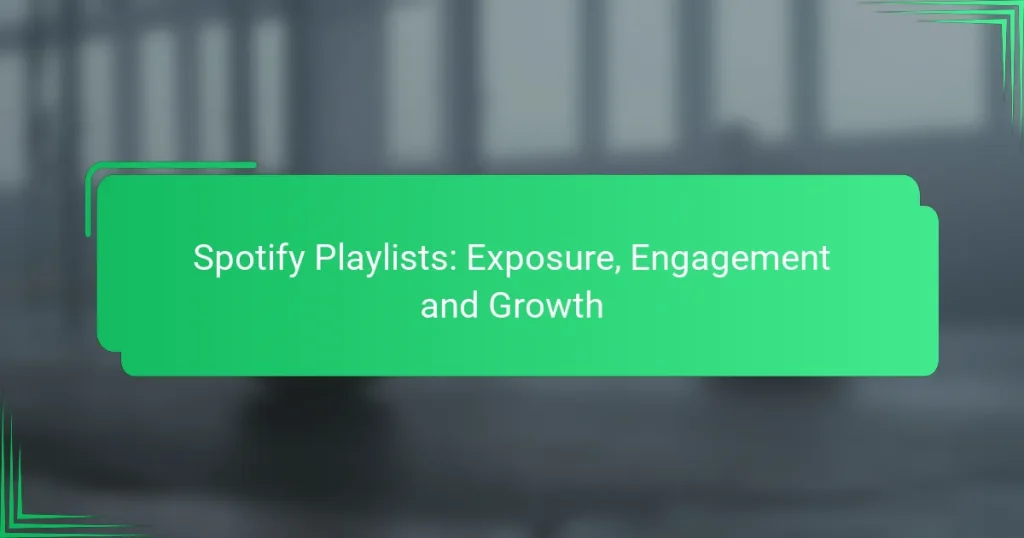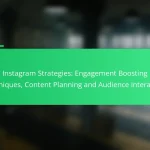Spotify playlists play a vital role in enhancing an artist’s exposure, connecting their music with a broader audience. By implementing effective engagement strategies, such as interactive elements and social media promotion, artists can foster listener loyalty and drive growth. Being featured on popular playlists not only increases streams and followers but also opens up new revenue opportunities.

How Can Spotify Playlists Increase Exposure?
Spotify playlists can significantly boost an artist’s exposure by placing their music in front of a larger audience. By leveraging various playlist features, artists can enhance their visibility and connect with potential fans.
Playlist features for visibility
Spotify offers several features that can enhance visibility for tracks included in playlists. For instance, playlists can be categorized by genre, mood, or activity, allowing users to discover music that fits their preferences. Additionally, playlists often appear on the platform’s homepage or in personalized recommendations, increasing the chances of being heard.
Artists should focus on getting their songs into playlists with a substantial following. The more followers a playlist has, the greater the potential reach for the music featured within it. Engaging with playlist curators and submitting tracks for consideration can be effective strategies to gain placement.
Collaborative playlists for audience reach
Collaborative playlists allow multiple users to add songs, creating a shared music experience. This feature can be particularly useful for artists looking to engage with their audience directly. By inviting fans to contribute to a playlist, artists can foster a sense of community and increase their reach.
To maximize the benefits of collaborative playlists, artists should promote these playlists on their social media channels. Encouraging fans to share the playlist can lead to organic growth and attract new listeners who may not have discovered the artist otherwise.
Curated playlists by influencers
Getting featured on curated playlists created by influencers or established curators can dramatically enhance an artist’s exposure. These playlists often have dedicated followings, and being included can introduce the artist’s music to a wider audience. Influencers typically look for fresh sounds, so submitting tracks that align with their style can increase the chances of being featured.
Artists should research and identify influencers whose playlists align with their genre. Building relationships with these curators through social media engagement or direct outreach can be beneficial. However, it’s essential to approach them respectfully and professionally to avoid coming across as overly promotional.
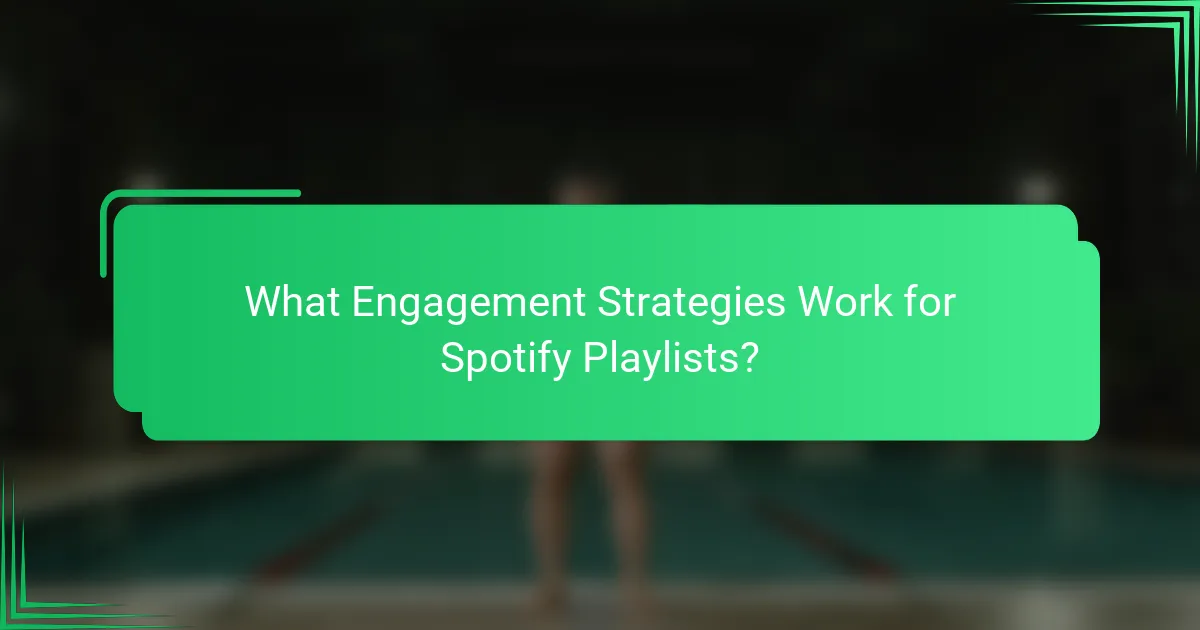
What Engagement Strategies Work for Spotify Playlists?
Effective engagement strategies for Spotify playlists focus on enhancing listener interaction and promoting the playlist across various channels. By incorporating interactive elements, leveraging social media, and encouraging user-generated content, playlist creators can significantly boost exposure and listener loyalty.
Interactive playlist elements
Interactive elements in playlists can greatly enhance user engagement. Features like polls, quizzes, or the ability to vote on songs can make listeners feel involved and valued. For instance, creating a playlist where fans can suggest tracks or vote on their favorites encourages participation and can lead to increased sharing.
Consider using Spotify’s Canvas feature, which allows artists to add short looping videos to their tracks. This visual element can capture attention and keep listeners engaged longer, potentially increasing the likelihood of playlist shares.
Social media promotion tactics
Promoting playlists on social media is crucial for reaching a wider audience. Share snippets of the playlist on platforms like Instagram, Twitter, and TikTok, utilizing engaging visuals and hashtags to attract attention. Collaborating with influencers or artists to promote the playlist can also expand its reach significantly.
Regularly update your audience about new additions or themes in your playlist. Creating countdowns or teaser posts can build anticipation and encourage followers to check back frequently, increasing overall engagement.
Fan engagement through user-generated content
Encouraging fans to create content related to your playlist can foster a sense of community and loyalty. Ask listeners to share their own playlists inspired by yours or to create videos featuring songs from your playlist. This not only promotes your playlist but also allows fans to feel a personal connection to the music.
Consider running contests where fans submit their own tracks or remixes for a chance to be featured in your playlist. This approach not only engages your audience but also diversifies the content, making the playlist more dynamic and appealing.
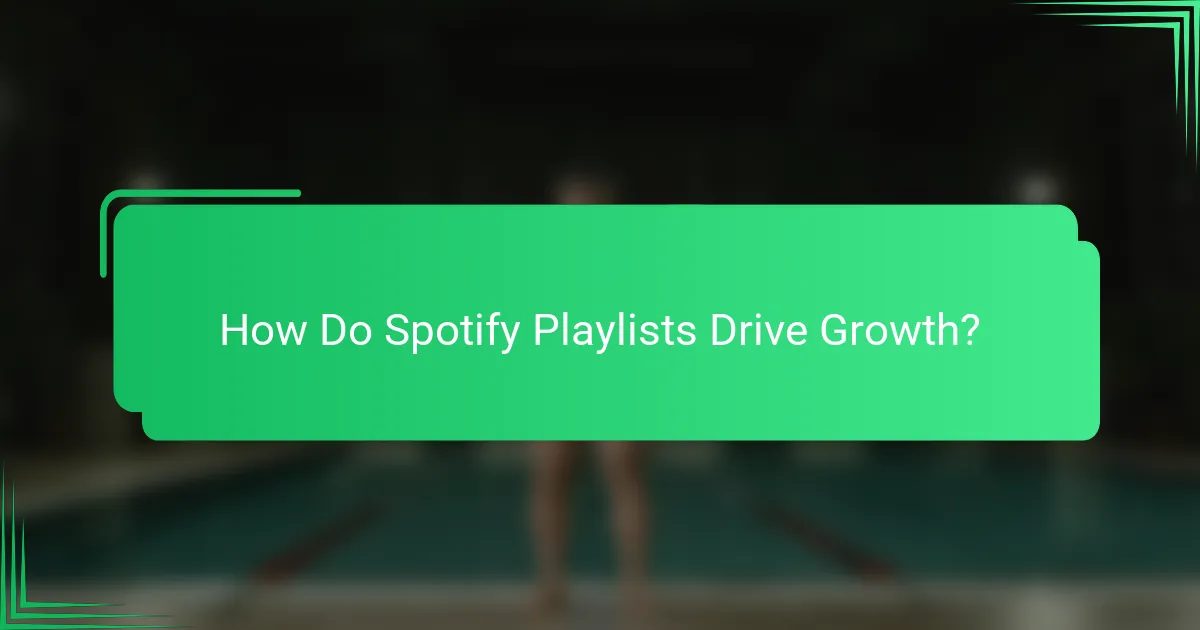
How Do Spotify Playlists Drive Growth?
Spotify playlists are crucial for driving growth by increasing exposure and engagement for artists. Being featured on popular playlists can significantly boost an artist’s reach, leading to more streams, followers, and potential revenue.
Playlist placements and algorithm impact
Getting placed on Spotify playlists can dramatically affect an artist’s visibility. The Spotify algorithm favors tracks that gain traction through playlists, which can lead to more recommendations and increased organic discovery.
Artists should aim for placements on both editorial and user-generated playlists. While editorial playlists are curated by Spotify’s team, user-generated playlists can also attract significant attention if they have a dedicated following.
Cross-promotion with other artists
Cross-promotion through playlist collaborations can enhance growth for all involved artists. By featuring each other’s tracks on playlists, artists can tap into each other’s audiences, expanding their reach.
Consider creating joint playlists with artists in similar genres or styles. This strategy not only diversifies content but also encourages fans to explore new music, benefiting all parties involved.
Data analytics for growth tracking
Utilizing Spotify’s analytics tools is essential for tracking growth and understanding audience engagement. Metrics such as stream counts, listener demographics, and playlist performance provide valuable insights into what works and what doesn’t.
Artists should regularly review their data to identify trends and adjust their strategies accordingly. For example, if a particular playlist drives significant traffic, it may be worth focusing more promotional efforts on similar playlists or genres.
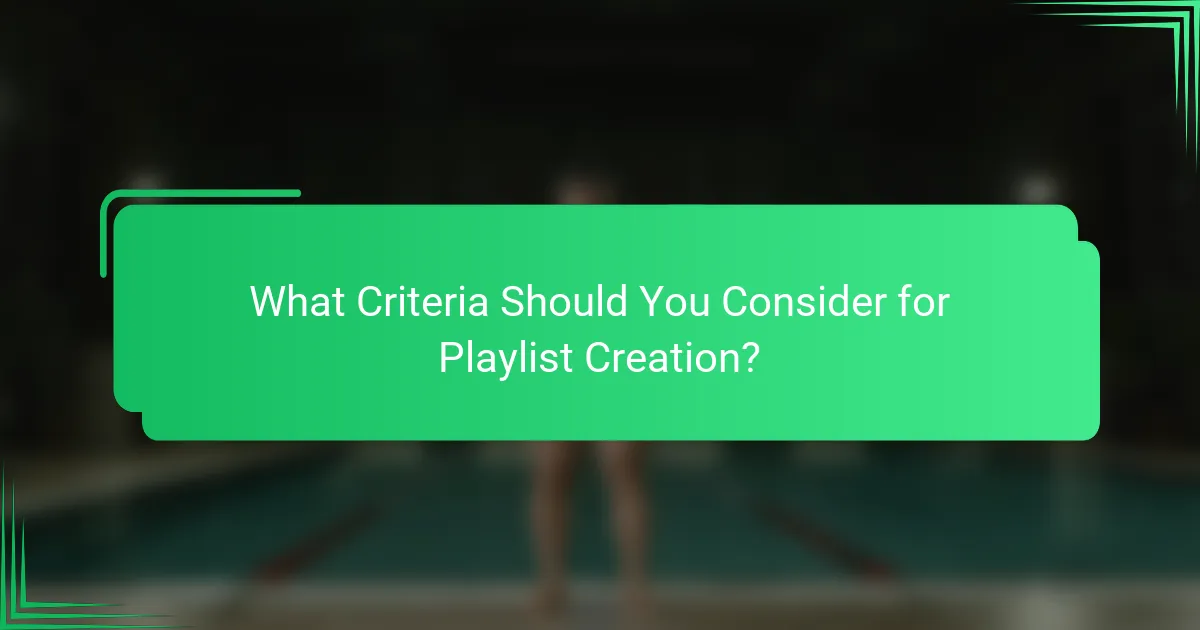
What Criteria Should You Consider for Playlist Creation?
When creating a playlist, consider factors such as your target audience, genre and mood alignment, and effective track selection strategies. These elements will help ensure your playlist resonates with listeners and encourages engagement.
Target audience identification
Identifying your target audience is crucial for playlist creation. Understand who you want to reach, whether it’s a specific age group, music preference, or cultural background. Tailoring your playlist to meet the tastes of your audience can significantly increase its popularity.
Consider using social media insights or streaming platform analytics to gather data on listener demographics. This information can guide your choices in track selection and overall playlist theme.
Genre and mood alignment
Aligning your playlist with a specific genre and mood helps create a cohesive listening experience. Choose a central theme, such as “chill vibes” or “upbeat party tracks,” and stick to it throughout the playlist. This consistency keeps listeners engaged and encourages them to return.
For example, if your playlist is designed for relaxation, include soft acoustic tracks or ambient music. Conversely, for a workout playlist, select high-energy songs that motivate and energize.
Track selection strategies
Effective track selection is key to a successful playlist. Start by curating a mix of popular hits and lesser-known tracks to maintain listener interest. Aim for a balance that showcases variety while still adhering to your genre and mood theme.
Consider using a simple checklist:
- Include a few current chart-toppers.
- Add some classic favorites.
- Incorporate emerging artists to introduce fresh sounds.
This strategy not only enhances the playlist’s appeal but also supports new talent in the music industry.
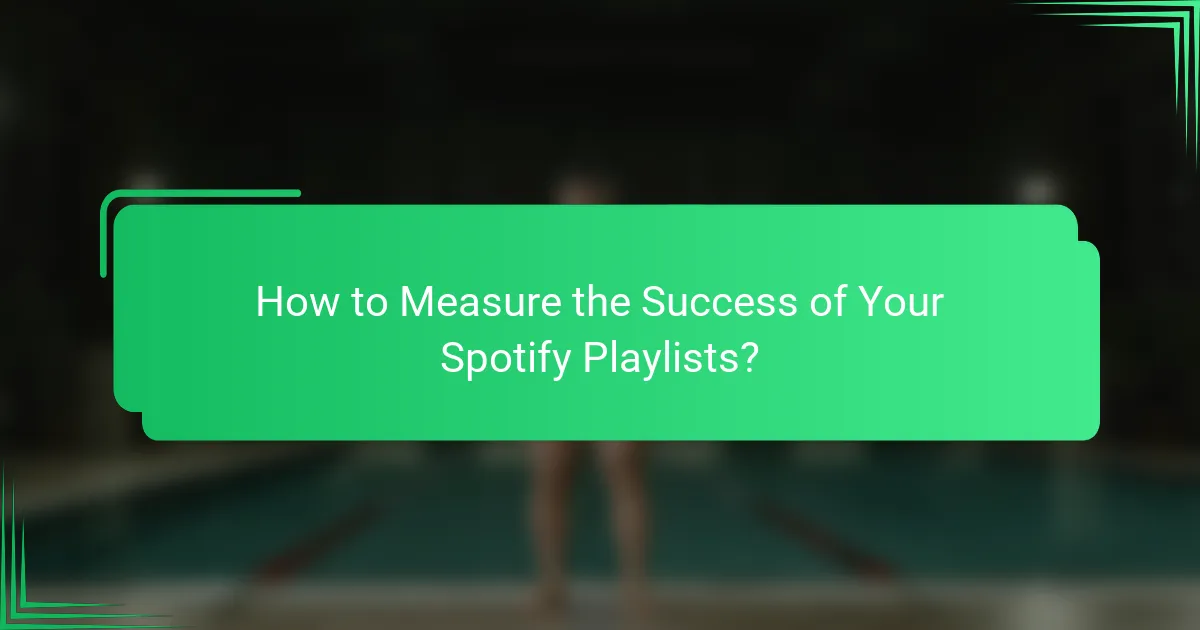
How to Measure the Success of Your Spotify Playlists?
To measure the success of your Spotify playlists, focus on key metrics such as engagement, follower growth, and listener retention. These indicators provide insights into how well your playlists resonate with audiences and contribute to overall growth.
Engagement metrics analysis
Engagement metrics include plays, skips, saves, and shares. High play counts suggest that your playlist is attracting listeners, while low skip rates indicate that users are enjoying the tracks. Analyze these metrics regularly to understand which songs or themes are most appealing.
Consider using Spotify for Artists to access detailed analytics. This platform allows you to view engagement trends over time, helping you identify which playlists drive the most interaction and which may need refreshing.
Follower growth tracking
Tracking follower growth is crucial for assessing the long-term success of your playlists. Monitor the number of followers gained over specific periods, such as weekly or monthly, to identify patterns. A steady increase suggests that your playlists are effectively attracting and retaining listeners.
Utilize tools like Spotify for Artists to set benchmarks for follower growth. Aim for a growth rate of 5-10% monthly as a reasonable target, adjusting your strategies based on what works best for your audience.
Listener retention rates
Listener retention rates measure how many users return to your playlists after their initial listen. High retention indicates that your content is engaging and worth revisiting. To calculate retention, track how many listeners return within a week or month after their first play.
To improve retention, regularly update your playlists with fresh content and maintain a cohesive theme. Aim for a retention rate of around 30-50% for optimal engagement, and experiment with different genres or moods to see what keeps listeners coming back.
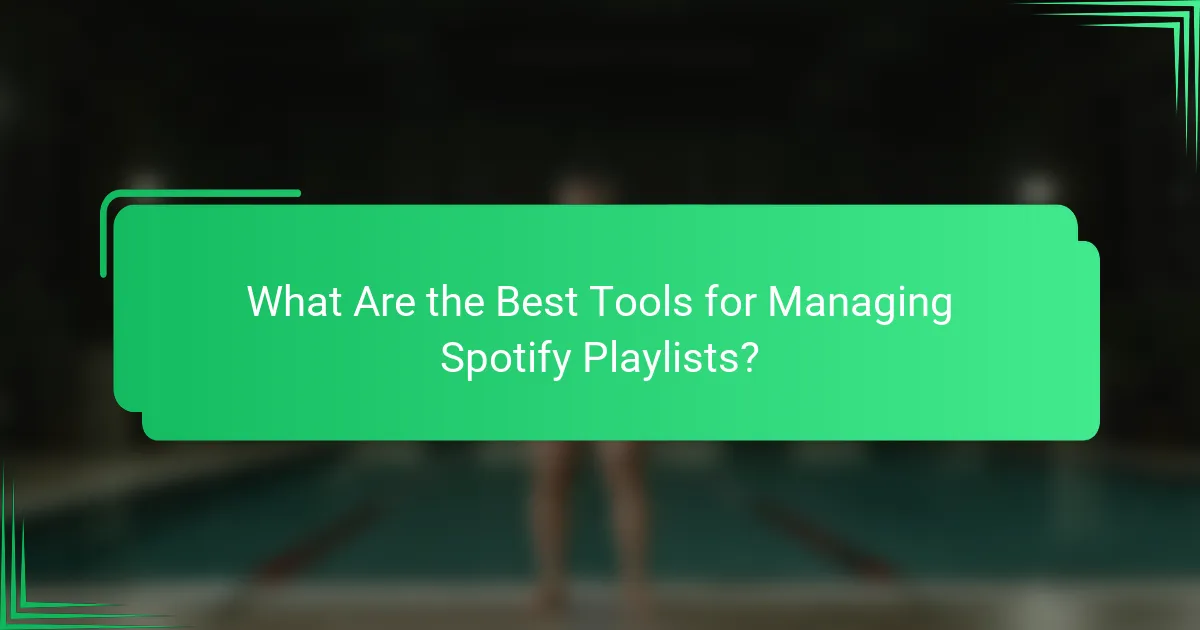
What Are the Best Tools for Managing Spotify Playlists?
Effective management of Spotify playlists can significantly enhance exposure and engagement. The best tools streamline playlist creation, organization, and promotion, helping users maximize their reach and listener interaction.
Playlist Management Software
Playlist management software allows users to create, edit, and organize playlists efficiently. Tools like Soundiiz and TuneMyMusic enable users to transfer playlists across different streaming platforms, ensuring a seamless experience. These tools often offer features such as bulk editing and analytics to track performance.
Analytics Tools
Analytics tools provide insights into how playlists are performing. Platforms like Spotify for Artists and Chartmetric offer data on listener demographics, engagement rates, and song performance. Understanding these metrics can help curators refine their playlists to better cater to their audience.
Social Media Integration
Integrating social media with Spotify playlists can boost visibility and engagement. Sharing playlists on platforms like Instagram, Twitter, and Facebook can attract new listeners. Using targeted hashtags and engaging visuals can further enhance the reach of your playlists.
Collaboration Features
Collaboration features on Spotify allow multiple users to contribute to a playlist, fostering community engagement. Users can invite friends or fans to add their favorite tracks, creating a more diverse listening experience. This collaborative approach can lead to increased shares and plays, benefiting all contributors.
